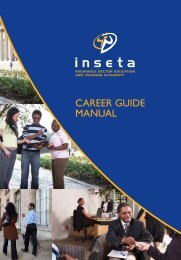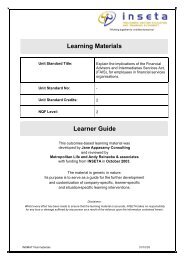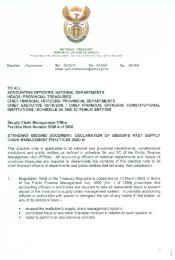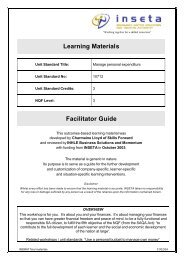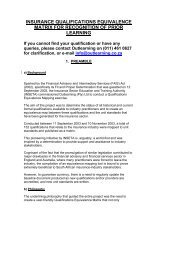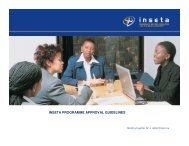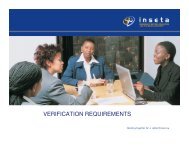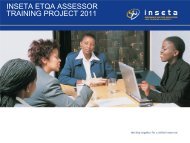SSP Brochure:Layout 1 - INSETA
SSP Brochure:Layout 1 - INSETA
SSP Brochure:Layout 1 - INSETA
Create successful ePaper yourself
Turn your PDF publications into a flip-book with our unique Google optimized e-Paper software.
3 THE SUPPLY OF SKILLS TO THE SECTOR3.1 IntroductionThe supply of skills to the sector is viewed from three perspectives: the stock of skills that is currently available in the labour market, theflow of new skills onto the market and the education and training interventions aimed at developing the skills of the existing labour force.The extent to which the supply of skills responds to the needs of the market is also assessed in this chapter.3.2 The stock of skills3.2.1 Current employmenta) QualificationsThe qualification profile of employees in the sector shows that the majority of employees obtained at least a qualification on NQFlevel 4. (Figure 3.1) While, managers and professionals would typically need qualifications at NQF Level 6 or higher, only 37% ofmanagers and 24.8% of professionals in the sector had obtained educational qualifications at this level. It should however be notedthat occupations on associated professional level are included in the professional category on the OFO. These occupations usuallyrequire qualifications on lower levels.Figure 3-1 Qualification levels of employeesSource: Inseta, Survey of Employment, Scarce and Critical Skills, May 2006The minimum qualifications required of personnel who are directly involved in the provision of financial services to the public are nowprescribed in the Fit and Proper Requirements for Financial Services Providers (FSPs). These requirements depend on the level oflicensing for which an individual applies and range from NQF level 2 to NQF level 6. All FSPs were required to apply for licensing bySeptember 2004 and had to comply with a first (or interim) set of minimum requirements by that time. They were, however, giventhree years after the first registration to obtain further minimum qualifications. A number of FSPs currently still do not have therequired qualifications. They are either in the process of upgrading their skills or they will deregister in 2009 48 . Between 10% and15% of the existing service providers will probably exit the industry in two to three years’ time because they cannot or do not wantto obtain the required qualifications. 49Clerical and administrative staff typically enter the sector with matric (or even lower) qualifications. They are mainly trained in-housein the systems and procedures of their employers.3.2.2 Population group and gender of employeesThe population group and gender distributions of employees in the sector are important indicators of the transformation of the sector.At the time of the Survey of Employment, Scarce and Critical Skills, almost half (49.5%) of the workforce was white, 28.0% was African,15.1% was coloured and 7.5% was Indian (Figure 3-2).48 The initial deadline of 2007 has been extended by the FSB to 31 December 2009. ftp://ftp.fsb.co.za/public/Faisdep/BoardNotice91of2006.pdf49 Estimate made by FPI in a personal interview.<strong>INSETA</strong> Sector Skills Plan - page 21




